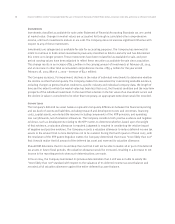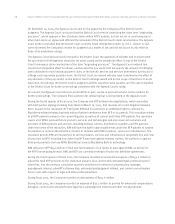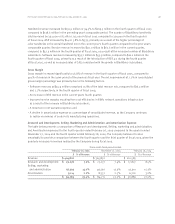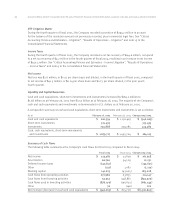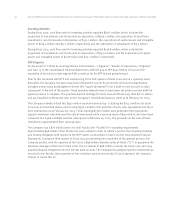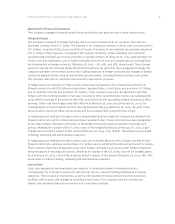Blackberry 2005 Annual Report Download - page 28
Download and view the complete annual report
Please find page 28 of the 2005 Blackberry annual report below. You can navigate through the pages in the report by either clicking on the pages listed below, or by using the keyword search tool below to find specific information within the annual report.
26
On December 14, 2004, the Appeals Court ruled on the appeal by the Company of the District Court’s
judgment. The Appeals Court concluded that the District Court erred in construing the claim term “originating
processor”, which appears in five of sixteen claims within NTP’s patents, but did not err in construing any of
other claim terms on appeal and affirmed the remainder of the District Court’s claim constructions. The Appeals
Court further concluded that the District Court correctly found infringement under 35 U.S.C. section 271(a),
correctly denied the Company’s motion for judgment as a matter of law and did not abuse its discretion in
three of its evidentiary rulings.
The Appeals Court decision would remand to the District Court the questions of whether and to what extent
the jury verdict of infringement should be set aside, based on the prejudicial effect, if any, of the District
Court’s erroneous claim construction of the term “originating processor”. The Appeals Court ordered that
should such prejudicial effect be shown, and because the jury verdict did not specify the amount of infringing
sales attributed to each individual patent claim, or the specific devices and services determined by the jury to
infringe each separately asserted claim, the District Court on remand will also have to determine the effect of
any alteration of the jury verdict on the District Court’s damage award and on the scope of the District Court’s
injunction. Accordingly, the District Court’s judgment and the injunction were vacated, and the case remanded
to the District Court for further proceedings consistent with the Appeals Court’s ruling.
As a result, the Appeals Court decision would affirm-in-part, vacate-in-part and remand certain matters for
further proceedings. The Company filed a petition for rehearing that is still pending in the Appeals Court.
During the fourth quarter of fiscal 2005, the Company and NTP entered into negotiations, which concluded
with both parties signing a binding term sheet on March 16, 2005, that resolves all current litigation between
them. As part of the resolution, NTP will grant RIM and its customers an unfettered right to continue its
BlackBerry-related wireless business without further interference from NTP or its patents. This resolution relates
to all NTP patents involved in the current litigation as well as all current and future NTP patents. The resolution
covers all of RIM’s past and future products, services and technologies and also covers all customers and
providers of RIM products and services, including wireless carriers, distributors, suppliers and ISV partners.
Under the terms of the resolution, RIM will have the right to grant sublicenses under the NTP patents to anyone
for products or services that interface, interact or combine with RIM’s products, services or infrastructure. The
resolution permits RIM and its partners to sell its products, services and infrastructure completely free and clear
of any claim by NTP, including any claims that NTP may have against wireless carriers, ISV partners or against
third-party products that use RIM’s BlackBerry Connect/BlackBerry Built-In technology.
RIM will pay to NTP $450 million in final and full resolution of all claims to date against RIM, as well as for
the NTP license going forward. RIM and NTP are currently working to finalize the definitive agreements.
During the fourth quarter of fiscal 2005, the Company recorded an incremental expense of $294.2 million to
adjust the total NTP provision to the resolution amount, plus current and estimated legal, professional and
other fees, less the previous cumulative quarterly provisions for enhanced compensatory damages,
prejudgment interest, plaintiff’s attorney fees, estimated postjudgment interest, and current and estimated
future costs with respect to legal and other professional fees.
During fiscal 2005, the Company recorded a total expense of $352.6 million.
During fiscal 2004, the Company recorded an expense of $35.2 million to provide for enhanced compensatory
damages, current and estimated future legal fees, postjudgment interest and other net adjustments.
Research In Motion Limited •Incorporated Under the Laws of Ontario (In thousands of United States dollars, except per share data, and except as otherwise indicated)


